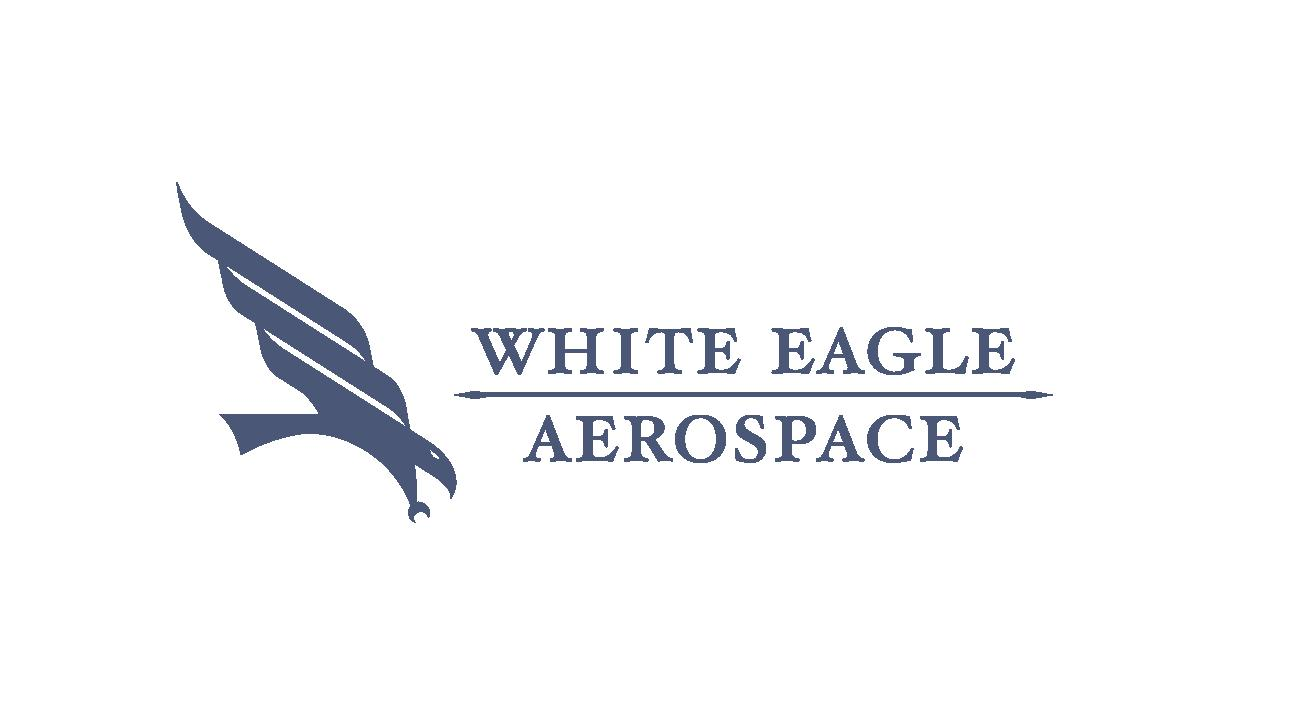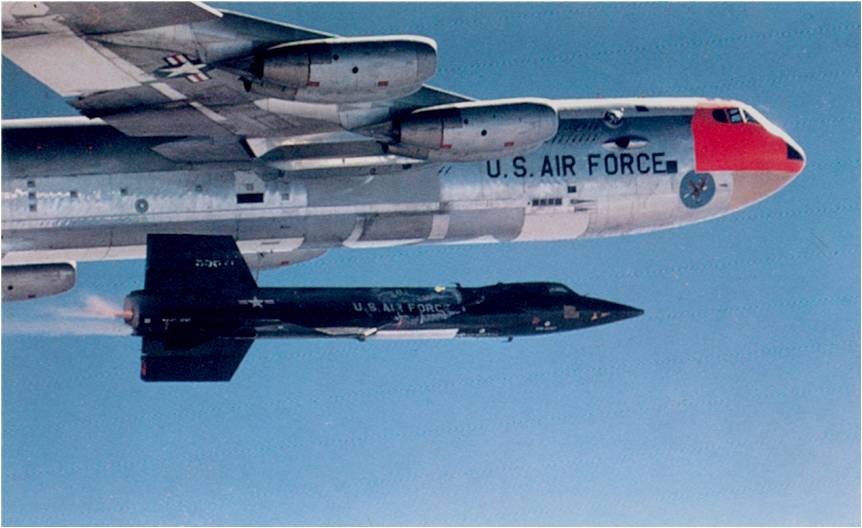
Forty-nine years ago this week, the USAF/NASA/North American X-15 became the first manned aircraft to exceed Mach 6. United States Air Force test pilot Major Robert M. White was at the controls of the legendary hypersonic flight research aircraft.
The North American X-15 was the first manned hypersonic aircraft. It was designed, engineered, constructed and first flown in the 1950’s. As originally conceived, the X-15 was designed to reach 4,000 mph (Mach 6) and 250,000 feet. Before its flight test career was over, the type would meet and exceed both performance goals.
North American built a trio of X-15 airframes; Ship No. 1 (S/N 56-6670), Ship No. 2 (56-6671) and Ship No. 3 (56-6672). The X-15 measured 50 feet in length, had a wing span of 22 feet and a GTOW of 33,000 lbs. Ship No. 2 would later be modified to the X-15A-2 enhanced performance configuration. The X-15A-2 had a length of 52.5 feet and a GTOW of around 56,000 lbs.
The Reaction Motors XLR-99 rocket engine powered the X-15. The small, but mighty XLR-99 generated 57,000 pounds of sea level thrust at full-throttle. It weighed only 910 pounds. The XLR-99 used anhydrous ammonia and LOX as propellants. Burn time varied between 83 seconds for the stock X-15 and about 150 seconds for the X-15A-2.
The X-15 was carried to drop conditions (typically Mach 0.8 at 42,000 feet) by a B-52 mothership. A pair of aircraft were used for this purpose; a B-52A (S/N 52-003) and a B-52B (S/N 52-008). Once dropped from the mothership, the X-15 pilot lit the XLR-99 to accelerate the aircraft. The X-15A-2 also carried a pair of drop tanks which provided propellants for a longer burn time than was possible with the stock X-15 flight.
The X-15 employed both aerodynamic and reaction flight controls. The latter were required to maintain vehicle attitude in space-equivalent flight. The X-15 pilot wore a full-pressure suit in consequence of the aircraft’s extreme altitude capability. The typical X-15 drop-to-landing flight duration was on the order of 10 minutes. All X-15 landings were performed deadstick.
On Thursday, 09 November 1961, USAF Major Robert M. White would fly his 11th X-15 mission. The X-15 and White had already become respectively the first aircraft and pilot to hit Mach 4 and Mach 5. On this particular day, White would be at the controls of X-15 Ship No. 2. The planned maximum Mach number for the mission was Mach 6.
At 17:57:17 UTC of the aforementioned day, X-15 Ship No. 2 was launched from the B-52B mothership commanded by USAF Captain Jack Allavie. Bob White lit the XLR-99 and pulled into a steep climb. Mid-way through the climb, White pushed-over and ultimately leveled-off at 101,600 feet. XLR-99 burnout occurred 83 seconds after ignition. At this point, White was traveling at 4,093 mph or Mach 6.04.
On this record flight, the X-15 was exposed to the most severe aerodynamic heating environment it had experienced to date. Decelerating through Mach 2.7, the right window pane on the X-15’s canopy shattered due to thermal stress. The glass pane remained intact, but White could not see out of it. Fortunately, he could see out of the left pane and made a successful deadstick landing on Rogers Dry Lake at Edwards AFB.
For his Mach 6+ flight, Bob White was a recipient of both the 1961 Collier Trophy and the Iven C. Kincheloe Award. The year before, White had received the Harmon Trophy for his X-15 flight test work. He would go on to fly the X-15 to a still-standing FAI altitude record of 314,750 feet in July of 1962. For this accomplishment, White was awarded USAF Astronaut Wings.
Bob White flew the X-15 a total of sixteen (16) times. He was one (1) of only twelve (12) men to fly the aircraft. White left X-15 Program and Edwards AFB in 1963. He went on to serve his country in numerous capacities as a member of the Air Force including flying 70 combat missions in Viet Nam. He returned to Edwards AFB as AFFTC Commander in August of 1970.
Major General Robert M. White retired from the United States Air Force in 1981. During his period of military service, he received numerous decorations and awards including the Air Force Cross, Distinguished Service Medal, Silver Star with three oak leaf clusters, Legion of Merit, Distinguished Flying Cross with four oak leaf clusters, Bronze Star Medal, and Air Medal with 16 oak leaf clusters.
Bob White was a true American hero. He was one of those heroes who neither sought nor received much notoreity for his accomplishments. He served his country and the aviation profession well. Bob White’s final flight occurred on Wednesday, 17 March 2010. He was 85 years of age.
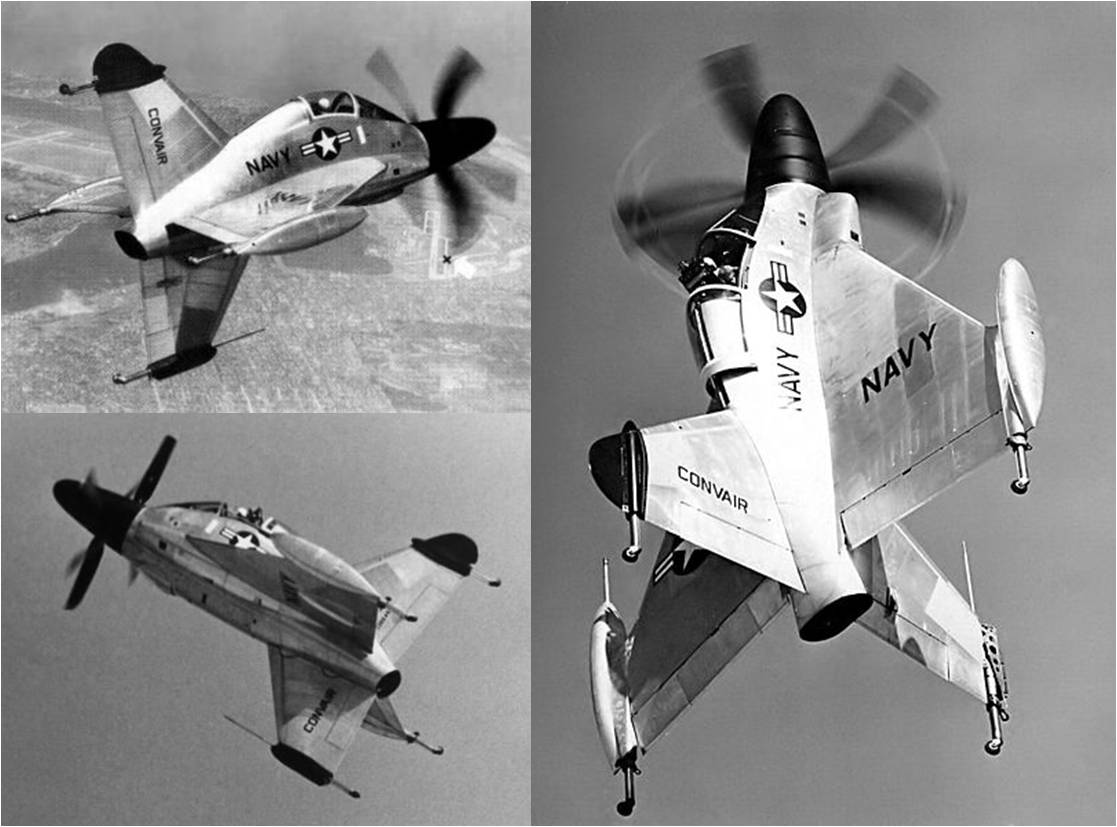
Fifty-six years ago this week, the USN/Convair XFY-1 became the first Vertical Take-Off and Landing (VTOL) aircraft to successfully transition from vertical to horizontal flight. The historic flight was piloted by famed Convair engineering test pilot James F. “Skeets” Coleman.
Motivated by World War II lessons-learned, the United States Navy began contemplating the feasibility of using VTOL aircraft for fleet defense in 1947. A VTOL aircraft would combine the vertical take-off and landing capabilities of a helicopter with the speed and agility of a fighter. The operational advantage and flexibility derived from basing such an aircraft on non-aircraft carrier naval vessels were powerful allurements indeed.
In May of 1951, the Navy awarded contracts to Lockheed and Convair to develop and flight test an experimental VTOL aircraft. The Lockheed offering was designated as the XFV-1 while Convair’s version became known as the XFY-1. Both companies were to produce two (2) test aircraft each. History records that each company would ultimately produce just a single copy of its respective prototype.
Convair nicknamed its VTOL aircraft Pogo after the Pogo Stick jumping toy popularized by an earlier generation of American youth. Such appellation referred to the XFY-1’s tendency to bounce on its quartet of shock-absorbered landing gear at touchdown. The similarity to one bouncing up and down on a spring-loaded Pogo Stick is obvious.
The XFY-1 Pogo measured 35 feet in length and had a wing span of nearly 29 feet. The type had a GTOW of 16,250 lbs and an empty weight of 11,750 lbs. Power was provided by a 5,500 hp Allison YT-40 turboprop which drove twin, 3-blade, 16-foot diameter contra-rotating propellers. This propulsion system produced a maximum thrust of 17,000 lbs.
The Pogo was difficult to fly vertically in close proximity to the ground. Prop-wash interaction with the aircraft and ground plane being the chief culprit. Even more difficult was the transition from vertical to horizontal flight and back again. It was particularly challenging to land the aircraft as the pilot had to look over his shoulder and “back down” to a landing.
The XFY-1 pilot sat in a seat that rotated to accommodate vertical and horizontal flight attitudes as appropriate. Pilot cockpit entry was via a 25-foot auxiliary ladder. Interestingly, the pilot was provided with a 25-foot rope for emergency egress during ground operations.
James F. “Skeets” Coleman was Convair’s project test pilot for XFY-1 flight tests. Coleman began tethered flight testing of the aircraft on Thursday, 29 April 1954 at NAS Moffett Field, California. Roughly 60 hours of tethered-flight testing took place within Moffett’s cavernous Hanger Number One. With a ceiling height of 195 feet, the building provided ample room for initial XFY-1 vertical flight testing.
On Sunday, 01 August 1954, Coleman made the first untethered XFY-1 flight test in the vertical. Following several more successful vertical take-off and landing trials, XFY-1 flight test activities were transferred to NAS Brown Field near San Diego, California. There, Coleman intently practiced (making 70 flights overall) in anticipation of the first attempt to transition the XFY-1 from vertical to horizontal flight.
On Tuesday, 02 November 1954, with Skeets Coleman at the controls, the XFY-1 lifted-off in the vertical from Brown Field. Coleman then carefully and skillfully transitioned the XFY-1 to horizontal flight for the first time. In 21 minutes of horizontal flight, Coleman put the nimble XFY-1 through its paces. The Pogo’s big Allison turboprop had power to spare as Coleman hit airspeeds well in excess of 300 mph.
When it was finally time to land the XFY-1, Coleman made a low altitude, minimum power approach and pulled into the vertical. As the aircraft quickly ascended, the airspeed bled-off just as rapidly. Near the top of the climb, Coleman advanced the throttle. The XFY-1 hung in the cool autumn air on the thrust of its twin props alone. The pilot then carefully descended from about 1,000 feet AGL and landed uneventfully.
Skeets Coleman made many more flights in which he demonstrated the Pogo’s VTOL capabilities. However, USN interest in the VTOL concept in general and the XFY-1 aircraft in particular began to wane. While the XFY-1 had indeed demonstrated the feasibility of VTOL flight, it also revealed the operational impracticality of such given the technology of the time.
The Achilles Heel of the Convair XFY-1 VTOL aircraft was the vertical landing phase. The pilot just could not judge rate-of-descent accurately. This was attributed partly to the fact that he had to look over his shoulder throughout the descent. In addition, XFY-1 throttle-induced lateral-directional handling qualities were poor and forced the pilot to work very hard at landing the aircraft even in low-wind conditions.
Skeets Coleman made the last flight of the XFY-1 experimental aircraft on Thursday, 16 June 1955. For his significant piloting efforts in successfully demonstrating the feasibility of the VTOL concept, he received the 1954 Harmon Trophy. The lone Convair XFY-1 Pogo test aircraft survived the flight test program and is currently held in the historical collection of the National Air and Space Museum.
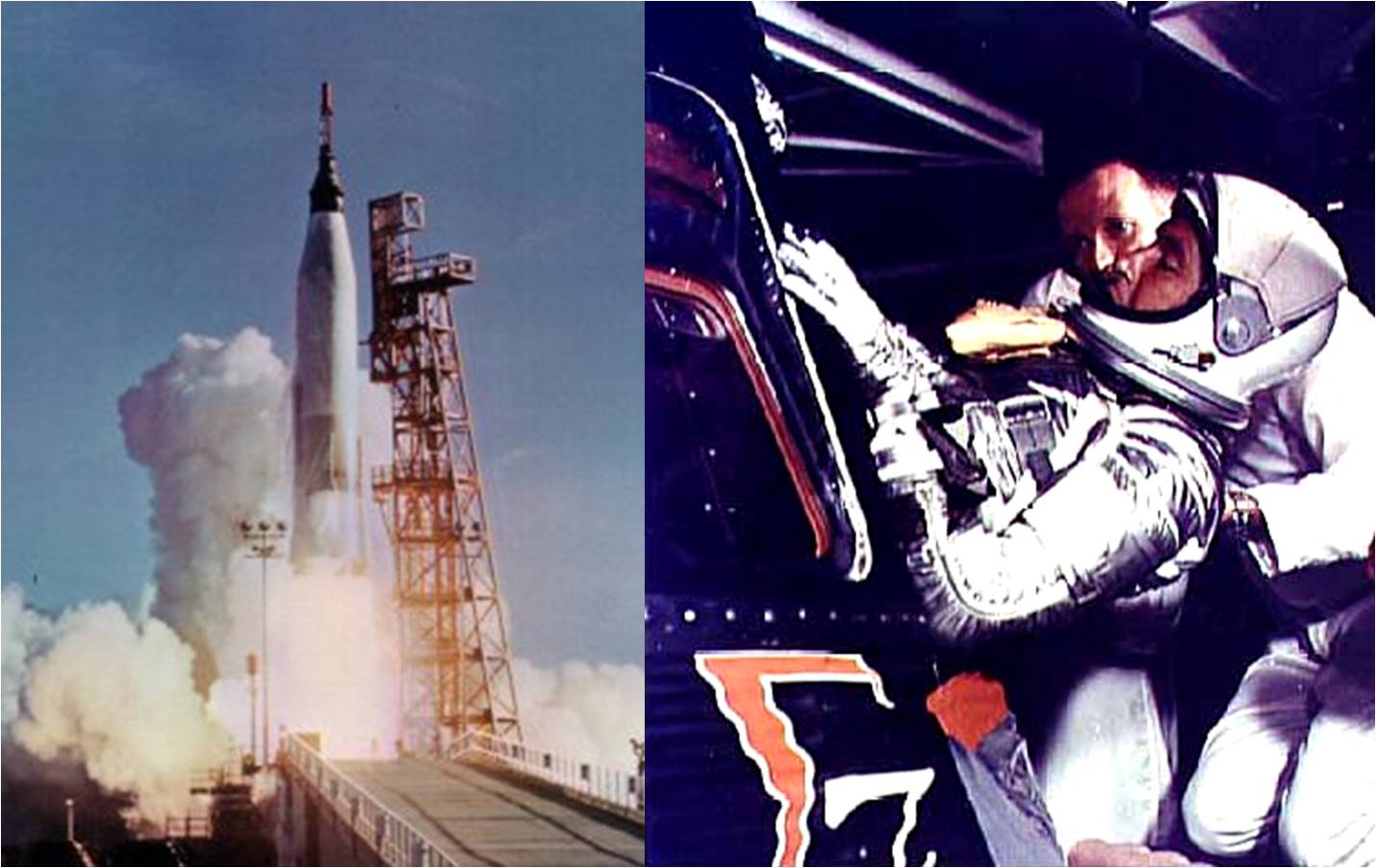
Forty-eight years ago this month, Mercury Astronaut Walter M. Schirra, Jr. orbited the Earth six (6) times in his Mercury spacecraft code-named Sigma 7. The near-perfect 9-hour spaceflight was the United States’ third manned orbital mission flown within a period of eight (8) months.
Project Mercury was United States’ first manned spaceflight program. This historic pioneering space effort helped lay the foundation for America’s quest for the Moon. A total of six (6) missions (2 sub-orbital and 4 orbital) was flown between May of 1961 and May of 1963.
The Mercury Spacecraft measured 11.5 feet in length and had a diameter of 6.2 feet. Orbital weight was roughly 3,000 pounds. With a cockpit volume of only 60 cubic feet, an astronaut’s corporeal fit inside the spacecraft was exceedingly tight. Vehicle entry and egress was a real shoe-horning process. It is not complete hyperbole to say that, once inside, an astronaut wore, more than rode in, the Mercury space vehicle.
Despite its dimunitive size, the Mercury Spacecraft was an able spacefaring ship. Indeed, it was configured with a complete suite of life support, navigation, attitude control, communications, deboost, recovery and thermal protection systems. Aided by a vast national mission support team, recovery force, and world-wide tracking system, the Mercury spaceflight effort was entirely successful in establishing America in space.
America’s first astronauts were known as the Mercury Seven. History records their names; Shepard, Grissom, Glenn, Carpenter, Schirra, Cooper and Slayton. In the tense 1960’s Space Race with the Soviet Union, these men were indeed America’s Single-Combat Warriors immortalized by writer Tom Wolfe in his classic, The Right Stuff.
Mercury-Atlas No. 8 (MA-8) was the fifth Mercury mission. Whereas the two (2) previous flights had been three (3) orbit missions, MA-8 was scheduled to orbit the Earth six (6) times. The focus would be on spacecraft operations instead of space science. The intent was to verify that the Mercury spacecraft could be cleared for an orbital mission duration of at least 24 hours on the very next flight
As was the custom for a Mercury astronaut, Schirra personally named his orbital steed. As such, Schirra chose the name Sigma 7. The term Sigma, the Greek mathematical symbol for summation, signified a summation or culmination of flight experience and engineering development that led to a mature Mercury Spacecraft system. The numeral 7 represented the Mercury Seven.
The MA-8 mission began with lift-off from Cape Canaveral’s LC-14 at 12:15:12 UTC on Wednesday, 03 October 1962. The Atlas D launch vehicle placed Schirra into a 152.8-nm x 86.9-nm orbit. Once in orbit, Schirra quickly got down to business. This included tracking the Atlas booster, maneuvering the spacecraft, observing and photographing the Earth, and conducting various scientific experiments.
Schirra did a particularly good job at conserving the precious supply of Reaction Control System (RCS) fuel. One of the MA-8 objectives had been to do so. In fact, Schirra conserved fuel even more efficiently than planned. Other than an annoying and uncomfortable spacesuit heating problem that occurred several times, the entire MA-8 mission was what Schirra would ultimately call “textbook”.
MA-8 retro-fire occurred at 21:07:12 UTC. During the reentry, the automatic rate stabilization system damped spacecraft pitch and yaw oscillations. Drogue and main parachute deployment took place at 40,000 feet and 15,000 feet, respectively. Splashdown in the Pacific Ocean occurred 1,200 nm northwest of Hawaii at 21:28:22 UTC.
The success of MA-8 paved the way to Gordon Cooper’s historic 22-orbit, 34-hour MA-9 mission in May of 1963. The Gemini and Apollo Programs would soon follow. Wally Schirra would play a big part in both. He commanded the historic Gemini 6 orbital rendezvous mission in December of 1965. Schirra also went on to command the critical Apollo 7 mission in October of 1968.
Wally Schirra was the only member of the Mercury Seven to orbit the Earth in Mercury, Gemini and Apollo spacecraft.
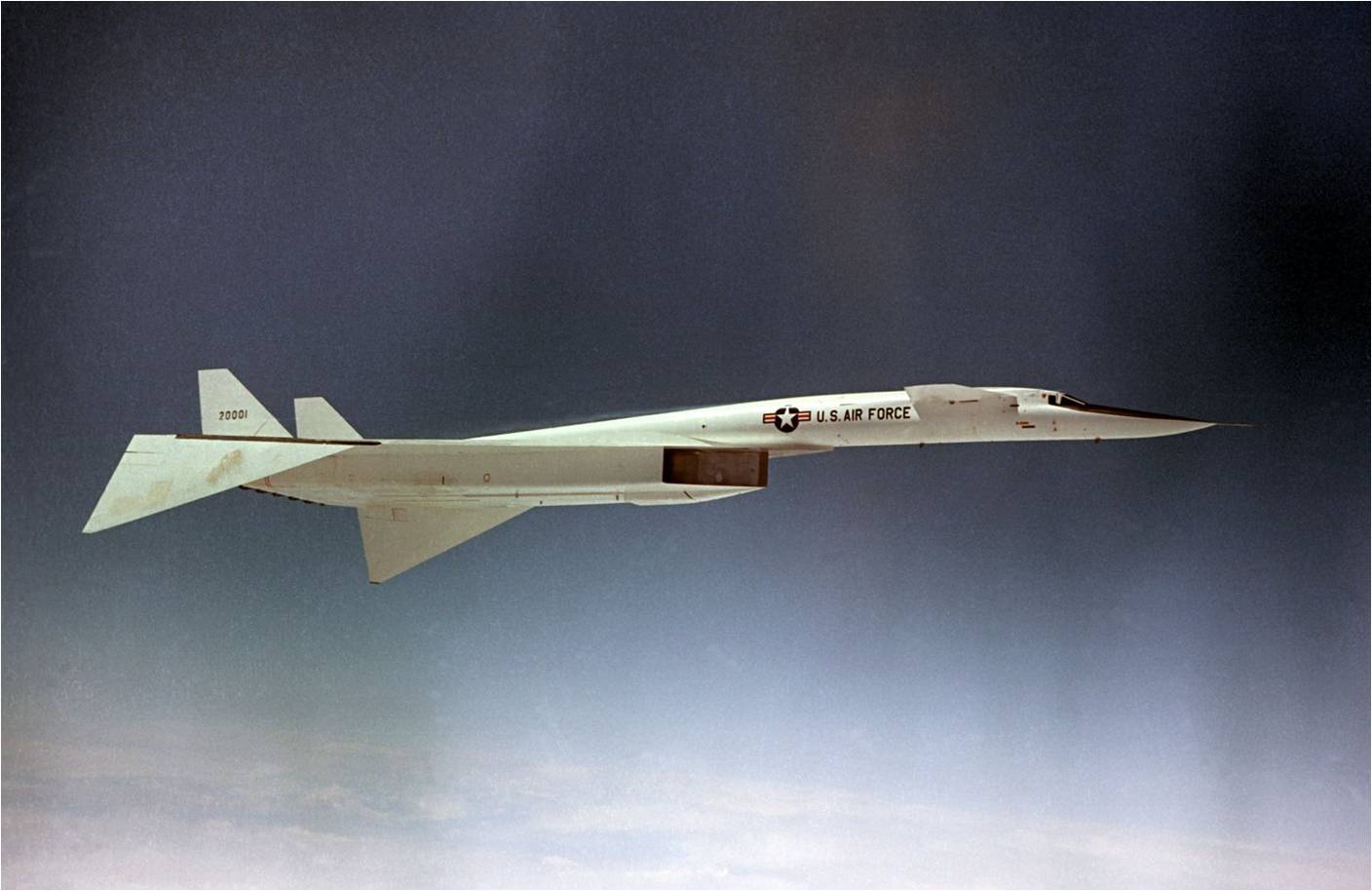
Forty-five years ago this month, the USAF/North American XB-70A Valkyrie reached three times the speed of sound for the first time. The historic aviation achievement took place on the 18th anniversary of the breaking of the sound barrier by the USAF/Bell XS-1.
When it comes to legendary aircraft, aviation enthusiasts speak in almost reverent terms about the XB-70A Valkyrie. Indeed, few aircraft have evoked such utter awe or symbolized better the profound majesty of flight than the “The Great White Bird”. Though its flight history was brief, the XB-70A’s influence on aviation has proven to be of enduring worth.
The Valkyrie measured 185 feet in length, had a wingspan of 105 feet and an empty weight of 210,000 pounds. With a GTOW of 550,000 pounds, it was the heaviest supersonic-capable aircraft of all-time. The aircraft was powered by a six-pack of General Electric YJ93-GE-3 turbojets totaling 172,200 pounds of thrust in afterburner.
To enhance lift-to-drag ratio and directional stability at high Mach number, the Valkyrie was configured with wing tips that could be deflected downward as much as 65 degrees. Each wing tip was the size of an USAF/Convair B-58A Hustler wing panel. To this day, the XB-70A deflectable wing tip is the largest control surface ever used on an aircraft.
The XB-70A was originally intended to be a supersonic strategic bomber. The aircraft’s mission was to penetrate Soviet airspace at Mach 3 and deliver nuclear ordnance from an altitude of 72,000 feet. However, the rapid ascendancy of Soviet surface-to-air missile capability would compromise the type’s military mission before it even flew.
As a consequence of the above, the Valkyrie ultimately became a high-speed flight research aircraft. Only two (2) copies were constructed and flown. Ship No. 1 (S/N 62-0001) made its maiden flight on Monday, 21 September 1964 while Ship No. 2 (62-0207) first took to the air on Saturday, 17 July 1965.
XB-70A Ship No. 1 became the first Valkyrie to hit Mach 3. It did so while flying at an altitude of 70,000 feet on Thursday, 14 October 1965. The flight crew consisted of North American Aviation test pilot Alvin S. White (aircraft commander) and USAF Colonel Joseph Cotton (co-pilot).
The XB-70A aircraft flew all of their flight research missions out of Edwards Air Force Base in California. Between September of 1964 and February of 1969, a total of 129 XB-70A research flights took places; 83 by Ship No. 1 and 46 by Ship No. 2. A total of nearly 253 flight hours was amassed by the aircraft.
The XB-70A Program made significant contributions to high-speed aircraft technology including aerodynamics, aerodynamic heating, flight controls, structures, materials, and air-breathing propulsion. Lessons-learned from its flight research have been applied to numerous aircraft developments including the B-1A, American SST, Concorde and the TU-144.
XB-70A Ship No. 1 survived the flight test program while Ship No. 2 did not. The latter was destroyed in a mid-air collision with a NASA F-104N on Wednesday, 08 June 1966. Today, XB-70A Ship No. 1 can be seen at the National Museum of the United States Air Force at Wright-Patterson Air Force Base in Dayton, Ohio.
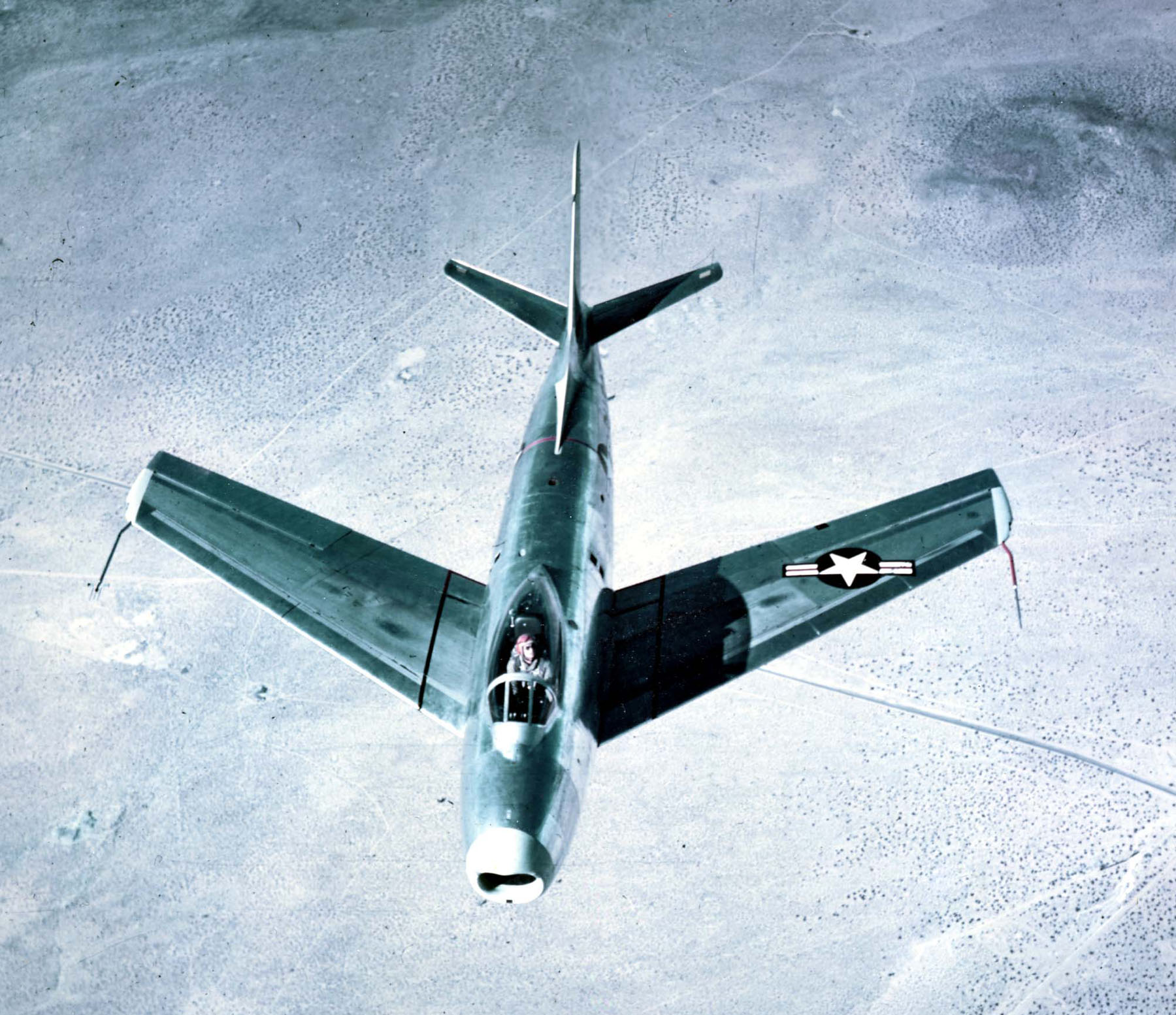
Sixty-three years ago this month, the swept-wing XP-86, the initial version of the famed USAF/North America F-86 Sabre, began flight testing at what is now Edwards Air Force Base. The popular Mig Alley legend would be produced in numerous variants and ultimately rack-up a total production run of nearly 10,000 aircraft worldwide.
In the waning days of World War II, the United States Army Air Force (USAAF) issued the requirements for a new high-speed, jet-powered fighter/interceptor aircraft. North American Aviation (NAA) captured the USAAF’s attention with a prototype swept-wing aircraft known as the XP-86. The “X” designation was shorthand for Experimental while the “P” stood for Pursuit.
The XP-86 (later designated as the XF-86 where “F” stood for Fighter) was the first United States fighter to incorporate wing sweep. The key benefit derived from sweeping the wings was to greatly reduce transonic wave drag. Based on aerodynamics data captured from the defeated Third Reich, NAA engineers designed the XF-86 with a wing sweep of 35 degrees.
A drawback to using wing sweep is that low-speed flight characteristics are adversely affected. The principal detrimental effect being a reduction in lift. However, NAA solved this problem by the incorporation of leading edge slats to enhance lift production at low speed.
The XF-86 measured roughly 37-feet both in length and wingspan. Empty weight was some 12,000 lbs. Power was provided by a Chevrolet J35-C-3 turbojet that generated a paltry 3,750 pounds of thrust. Later variants of the Sabre would be powered by jet engines generating nearly 10,000 pounds of thrust.
On Wednesday, 01 October 1947, XF-86 No. 1 took to the air for the first time from Muroc Army Air Field, California. USAAF Major and WW II 16-kill ace George S. “Wheaties” Welch was at the controls of the XF-86. Intestingly, the historical record strongly suggests that Welch exceeded the speed of sound during a dive on that first flight test.
The case of George Welch is an intriguing sub-plot of the F-86 Sabre story. Welch was stationed at Pearl Harbor on 07 December 1941. He was one of the very few American pilots to get in the air and fight the attacking Japanese forces. Numerically overwhelmed, he nontheless splashed four (4) enemy aircraft and lived to fly and fight another day.
Welch served three (3) combat tours in WW II for a total of 348 combat missions. After leaving the service in 1944, he joined North American Aviation as a test pilot. Welch progressed quickly and became NAA’s Chief Test Pilot. This path ultimately led to Welch flight testing the XP-86 Sabre.
Although denied verification in official Air Force records, both oral history and strong circumstantial evidence points to the high likelihood that Welch exceeded Mach 1 at least twice before the Bell XS-1 did so on Tuesday, 14 October 1947.
Incredibly, the first instance of Welch and the XF-86 exceeding Mach 1 was on the occasion of its first flight test! Welch dove the aircraft from 35,000 feet and reportedly generated a weak sonic boom.
The second instance of Mach 1 exceedance reportedly occurred on Tuesday, 14 October 1947. This time Welch dove the XF-86 from 37,000 feet and generated a stronger sonic boom. Apparently, this event took place just before the Bell XS-1, with USAAF Major Charles E. “Chuck” Yeager at the controls, achieved Mach 1.06 later that same morning.
Welch was never officially credited with being the first to achieve supesonic flight. A number of reasons account for this circumstance. First, his aircraft was not instrumented properly to verify flight performance at quasi-supersonic speeds. Additionally, Welch’s aircraft was not tracked by radar.
In addition to the technical reasons cited above, there was political intrigue surrounding Welch’s supersonic dive flights as well. NAA (and thus Welch) had been ordered not to exceed Mach 1 before the rocket-powered Bell XS-1 did so. Perhaps the only concession accorded Welch was that USAF later referred to Yeager’s historic superonic flight as the first time the sound barrier was broken in level flight.
George Welch went on to a distinguished, but all too brief flight test career. On Monday, 25 May 1953, he became the first man to exceed Mach 1 in level flight in a jet-powered production aircraft. That aircraft was the North American F-100 Super Sabre. Welch perished on Tuesday, 12 October 1954 when his YF-100A went out of control and distintegrated during a 7-g pull-up at Mach 1.55.
For its part, the F-86 Sabre ultimately served long and well in the air forces of the United States and a host of other western-friendly nations. Perhaps its greatest claim to fame accrues from the type’s remarkable aerial combat perfromance in the Korean War. Indeed, despite being numerically bested by Soviet-built MIG-15 aircraft, the official record shows that USAF pilots made 792 kills flying the Sabre. Compared with 76 kills made by the opposition, the Sabre registered a phenomenal 10:1 kill ratio.
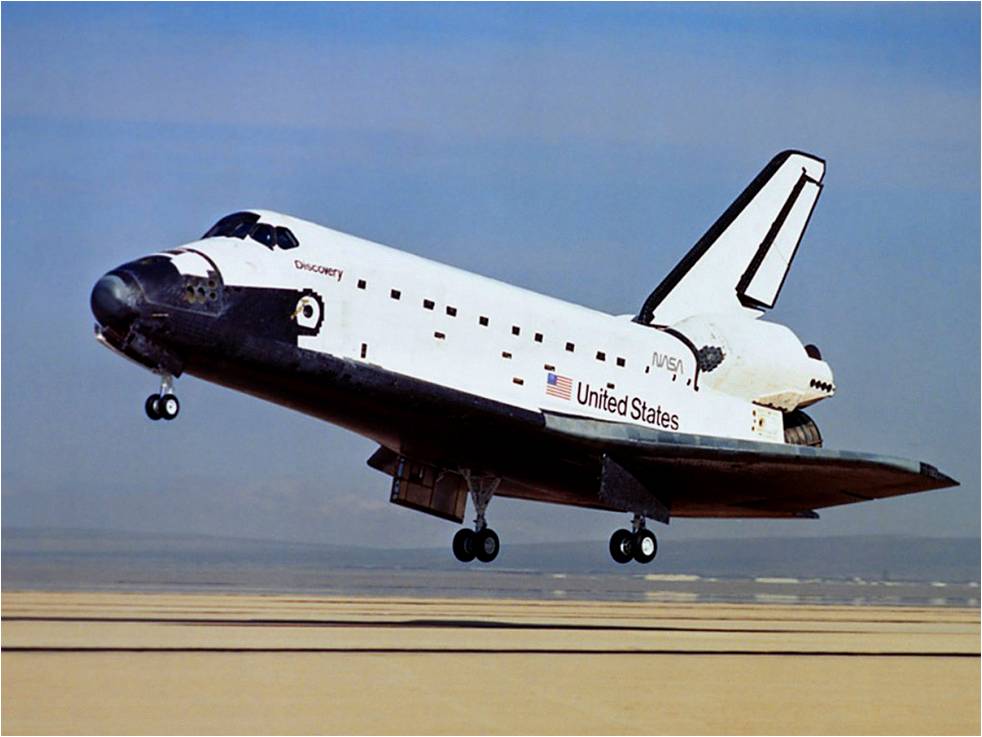
Twenty-two years ago this week, the Space Shuttle Discovery and its five man crew landed on Rogers Dry Lake at Edwards Air Force Base to successfully complete the Return-to-Flight (RTF) mission of STS-26. The flight signaled a resumption of the Space Shuttle Program after a 32-month hiatus in manned spaceflight resulting from the Challenger disaster.
Well chronicled is the tragic loss of the Space Shuttle Challenger and its crew of seven on Tuesday, 28 January 1986. Following lift-off at 16:38 UTC from Cape Canaveral’s LC-39B, the launch vehicle distintegrated 73 seconds into flight. The presidentially-appointed Rogers Commission concluded that the primary cause was failure of an O-ring seal in a field joint of the right Solid Rocket Booster (SRB).
While the SRB O-ring failure was the physical cause of the Challenger mishap, the Rogers Commission brought to light a more fundamental and disturbing reason for the tragedy. Specifically, the very decision to launch Challenger on that unusally cold January morning in Florida was fundamentally flawed.
As chillingly delineated in Dianne Vaughan’s “The Challenger Launch Decision”, a culture of deviance with respect to Shuttle flight safety issues had slowly developed at NASA. Pressure to launch, scarce resources and organizational disconnects contributed to NASA management’s blind spot when it came to Shuttle flight safety. The SRB contractor was culpable as well and for the same reasons.
Following redesign and testing of the SRB field joints and the implementation of a myriad of other fixes, NASA prepared to return the Shuttle to flight. The mission was designated as STS-26. To the Space Shuttle Discovery would go the honor of and the responsibility for flying the RTF mission. STS-26 was to be a five day orbital mission.
A five-member crew was selected by NASA to fly STS-26. Each crew member had spaceflight experience. You remember their names. Mission Commander Frederick H. “Rick” Hauck, Pilot Richard O. Covey, and Mission Specialists John M. “Mike” Lounge, George D. “Pinky” Nelson and David C. Hilmers.
Discovery and her brave crew lifted-off from at 15:37 UTC on Thursday, 29 September 1988 from the very same location that Challenger did; LC-39B at Cape Canaveral, Florida. Millions watched that day. Some were in the big crowds that formed in and around the Cape complex. Most observed the event on television. Many prayed.
All who watched Discovery lift-off that day remembered the previous Shuttle flight. Indeed, they remembered what happened just after the CAPCOM’s call: “Challenger, go at throttle-up.” (Ironically, Richard Covey was the CAPCOM who made that very call.) Today, they heard a similar call over the Shuttle communications network: “Discovery, go at throttle-up.” A collective breath was held. After throttle-up, Discovery continued all the way to orbit. YES!!!
The mission itself seemed to be anti-climatic. A Tracking and Data Relay Satellite (TDRS) was deployed from Discovery’s payload bay to replace the one lost in the Challenger explosion. A multitude of space experiments was conducted by the crew. Fairly standard stuff. Only deboost, the rigors of reentry and the typical dead-stick landing lay ahead.
Discovery landed on Runway 17 at Edwards Air Force Base on Monday, 03 October 1988. Main gear touchdown occurred at 16:37 UTC. Approximately, 450,000 American’s witnessed Discovery’s landing in person. A few who did had witnessed its launch in person as well.
The emotion that attended Discovery’s landing in October 1988 was simply overwhelming. Indeed, the experience was an integral part of the healing process for a Nation that still grieved the loss of Challenger and her crew. A Time magazine cover page headline the following week excitedly read: “Whew! America Returns to Space” And indeed it had.
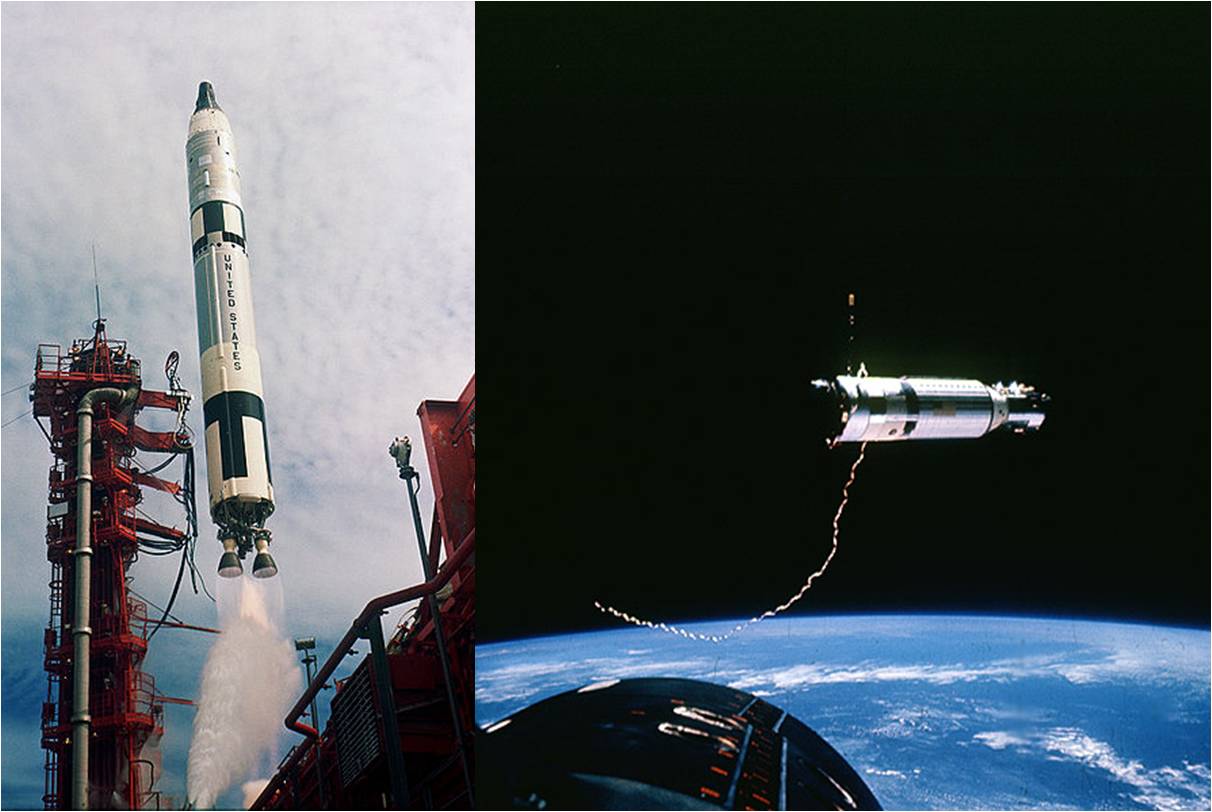
Forty-four years ago this month, Gemini 11 flew a spectacular 3-day mission that helped pave the way to the first manned lunar landing. The all-Navy crew included astronauts Charles P. Conrad, Jr. and Richard F. Gordon, Jr.
America’s manned space effort of the 1960’s and early 1970’s consisted of the Mercury, Gemini and Apollo Programs. Mercury put the first Americans into space and gave the country a basic manned spaceflight capability. Apollo put Americans on the Moon and returned them safely to the Earth. Gemini was the bridge. Without it, the United States could not have achieved the national goal of landing men on the Moon before the end of the 1960’s.
The Gemini Program consisted of ten (10) manned spaceflights that were flown between March of 1965 and December 1966. Gemini 11 was the penultimate mission. Its primary goals included performing a direct ascent rendezvous, increasing its orbital altitude by more than 500 NM, using tethered flight to produce artificial gravity, conducting several space walks and performing a computer-controlled precision landing.
Gemini 11 lifted-off from Cape Canaveral’s LC-19 at 14:42:26 UTC on Monday, 12 September 1966. The initial orbit was 151-NM (apogee) by 87-NM (perigee). Relying on radar and a primitive flight computer, it took Conrad and Gordon about 85 minutes to successfully perform history’s first direct ascent or first-orbit rendezvous. Their target was an Agena Target Vehicle (GATV-11) which had been launched 90 minutes prior to Gemini 11’s lift-off.
Approximately 24 hours into the Gemini 11 mission, Gordon initiated the first of two planned Extra Vehicular Activities (EVA’s). His first task was to connect a 100-foot tether between the Gemini and Agena spacecraft. While he did so successfully, Gordon was exhausted from the effort. He perspired so heavily that his helmet face plate fogged-over. The remainder of the EVA was cancelled when Conrad commanded Gordon to return to the Gemini.
At a mission elapsed time of about 40.5 hours, the Gemini 11 crew fired-up the Agena’s rocket engine for a 25 second burn. This action increased the apogee of the Gemini-Agena stack to a record altitude of 739 NM. Following two (2) highly-elliptical orbits, the Agena’s rocket engine was once again ignited. The result of this rocket engine burn was to lower the spacecraft and its crew to a near-circular 164 NM x 155 NM orbit.
Roughly 46 hours into the mission, Gordon conducted a second EVA. This time Gordon would simply stand-up in his seat and conduct several hours of photographic experiments. Doing so was not physically-taxing and Gordon’s efforts were entirely successful.
Following successful completion of the second EVA, the Gemini undocked from the ATV. With the spacecraft still connected by the 100-foot tether, the crew used the Gemini’s thrusters to establish a slow rotation of the pair until the tether became taut. The idea was to induce a small artificial gravity between the rotating spacecraft. Keeping the tether taut was not easy. While this was another first for Gemini, the maximum artificial gravity induced was a paltry 0.00015-g.
Upon completion of the tethered-flight experiment, the tether connecting Gemini 11 and the GATV-11 was released at a mission elapsed time of about 51 hours. The Gemini 11 crew performed additional spacecraft manuevers and conducted a variety of spaceflight experiments over the next 19 hours. However, Gemini 11 had one more historic space-first to accomplish before mission’s end.
As the 70th hour of flight neared completion, the crew fired the Gemini 11 retro rocket system to begin their return to Earth. For the first time, a Gemini crew would allow a computer to control the reentry. A so-called “hands-off” reentry. All previous Gemini reentries were manually controlled by the command pilot.
Gemini 11 splashed-down in the western Atlantic Ocean at 13:59:35 UTC on Thursday, 15 September 1966. The computer did a pretty good job of controlling the reentry too. The spacecraft landed within 2.4 NM of the USS Guam; only 1.3 NM off target. The accurate landing allowed recovery of, first the crew, then the spacecraft, aboard the Guam within an hour of landing. Mission total elapsed time was 71 hours, 17 minutes and 8 seconds.
For their significant efforts on Gemini 11, the crew of Conrad and Gordon would eventually fly to the Moon during the Apollo Program. Indeed, Pete Conrad was the Commander of Apollo 12 and the third American to walk on the Moon. (Alan Bean was the Apollo 12 Lunar Module Pilot and the fourth man to walk the lunar surface. ) Conrad’s Command Module Pilot was none other than his good friend and Gemini 11 co-pilot Richard Gordon.
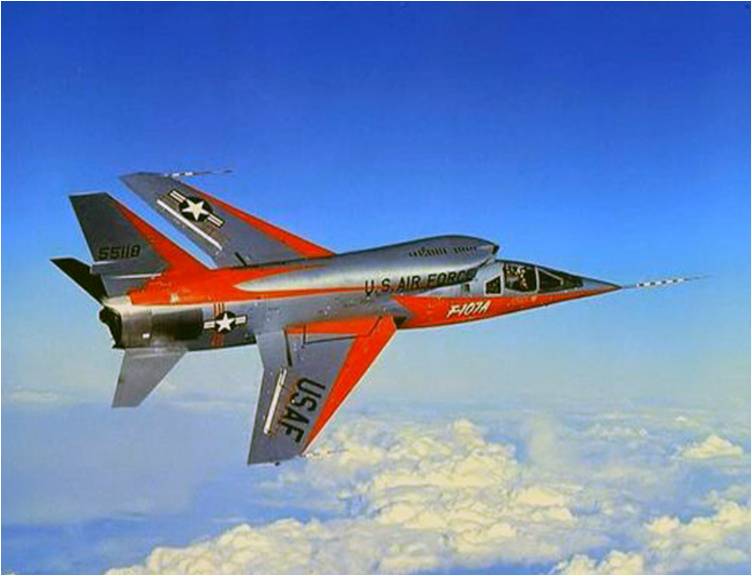
Fifty-four years ago this month, the USAF/North American F-107A aircraft flew for the first time. The Mach 2-capable fighter-bomber went supersonic on the type’s maiden flight.
The F-107A was designed, developed and tested by North American Aviation (NAA) in the mid-1950’s. With it, the contractor hoped to satisfy Tactical Air Command’s (TAC) need for a front line fighter-bomber. However, Republic Aircraft also had a candidate for the same role; the F-105 Thunder Chief.
The competition between Republic and North American for the TAC fighter-bomber production contract has a story of its own. Suffice it to say here that the competitive effort was (1) extremely close and (2) tinged with political intrigue. In the end, Republic Aircraft reaped the spoils of victory.
Although the F-107A came out on the short end of the stick in the TAC fighter-bomber competition, such did not imply an inferiority in fulfilling the intended role. Indeed, like the Northtrop YF-23’s loss to the General Dynamics YF-22 in the ATF competition of the early 1990’s, North American’s failure to get the nod with the F-107A is still a subject of passionate debate.
The F-107A measured 60.8 feet in length and had a wing span of 36.6 feet. Gross take-off weight was around 41,000 pounds. The aircraft was powered by a single Pratt and Whitney YJ75-P-11 turbojet that produced 15,500 pounds of thrust in military power and 23,500 pounds of thrust in full afterburner.
F-107A longitudinal control was provided by an all-flying horizontal tail. Similarly, an all-flying vertical tail was employed for directional control. Lateral control was provided by a unique 3-segment spoiler-deflector system mounted on each wing. The aircraft was also configured with inboard flaps and leading edge slats for lift augmentation at low speeds.
A unique and prominent feature of the F-107A was its dorsal-mounted air induction system known as the Variable-Area Inlet Duct (VAID). Internally, this unit incorporated a system of adjustable ramps to efficiently decelerate and compress freestream prior to entering the engine compressor face. Ramp deflection scheduling with Mach number was controlled automatically. Ramp boundary layer bleed air was vented from the top of the VAID.
The F-107A carried weapons externally. In addition to wing pylon-mounted stores, the aircraft was designed to carry a single “special weapon” from a semi-submerged recess located on the aircraft ventral centerline. The term “special weapon” means that it was a tactical nuclear bomb. The Sandia-developed store could also be used in combination with a special saddle fuel tank to extend aircraft range.
A total of three (3) F-107A aircraft were built and flown. USAF-assigned tail numbers include 55-5118, 55-5119 and 55-5120. On Monday, 10 September 1956, the No. 1 ship (55-5118) took-off from Edwards Air Force Base on its first flight. NAA Chief Test Pilot Robert Baker, Jr. was at the controls. The aircraft attained a maximum Mach number of 1.03 in a 43 minute flight test.
The F-107A could really scream. The type had a maximum climb rate of around 40,000 feet per minute in full afterburner. The max demonstrated Mach number attained by the F-107A was Mach 2.18. Program engineers estimated that by increasing the inlet area slightly, the F-107A was capable of reaching roughly Mach 2.4.
The trio of F-107A aircraft flew 272 flight tests totalling 176.5 hours. Included in this testing was successful separation of a special store prototype at Mach 2. Test pilots of note who flew the F-107A included XB-70A pilot Al White and X-15 pilots Scott Crossfield, Bob White, Jack McKay and Forrest Peterson.
Though it never became a production aircraft, the F-107A contributed in significant ways to aviation progress. Indeed, many future aircraft would greatly benefit from F-107A flight control and air induction technology including the A-5 Vigilante, XB-70A, A-12, SR-71, YF-12A and F-15.
The F-107A was the last of NAA’s fighter aircraft which includes such notables as the P-51 Mustang, the F-86 Sabre and the F-100 Super Sabre. While the F-107A has often been referred to in print as the Ultra Sabre, Ultimate Sabre, Super Super Sabre or such, it was never officially assigned a nickname. Alas, there was never an XF-107A or YF-107A designation either. North American Aviation’s TAC fighter-bomber candidate was simply known as the F-107A.
Today, the No. 1 F-107A (55-5118) is displayed at the Pima Air and Space Museum (PASM) in Tucson, Arizona. The No. 2 ship (55-5119) resides at the USAF Museum at Wright-Patterson Air Force Base in Dayton, Ohio. The No. 3 airplane (55-5120) no longer exists as it was relegated to the status of a fire fighting prop and ultimately destroyed in that role sometime in 1961 or 1962.
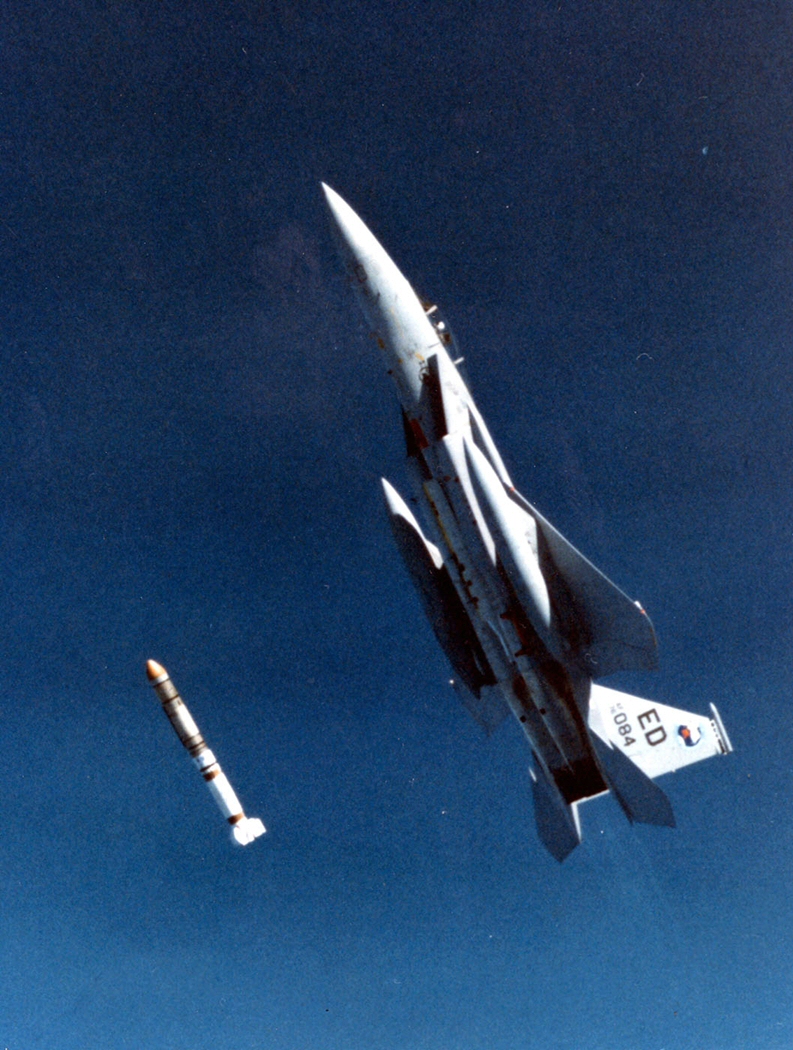
Twenty-five years ago today, the USAF/LTV ASM-135 anti-satellite missile successfully intercepted a target satellite orbiting 300 nautical miles above the Earth. The test was the first and only time that an aircraft-launched missile successfully engaged and destroyed an orbiting spacecraft.
The United States began testing anti-satellite missiles in the late 1950’s. These and subsequent vehicles used nuclear warheads to destroy orbiting satellites. A serious disadvantage of this approach was that a nuclear detonation intended to destroy an adversary satellite will likely damage nearby friendly satellites as well.
By the mid 1970’s, the favored anti-satellite (ASAT) approach had changed from nuclear detonation to kinetic kill. This latter approach required the interceptor to directly hit the target. The 15,000-mph closing velocity provided enough kinetic energy to totally destroy the target. Thus, no warhead was required.
The decision to proceed with development and deployment of a US kinetic kill weapon was made by President Jimmy Carter in 1978. Carter’s decision came in the aftermath of the Soviet Union’s successful demonstration of an orbital anti-satellite system.
LTV Aerospace was awarded a contract in 1979 to develop the Air-Launched Miniature Vehicle (ALMV) for the USAF. The resulting anti-satellite missile (ASM) system was designated the ASM-135. The two-stage missile was to be air-launched by a USAF F-15A Eagle executing a zoom climb. In essence, the aircraft acted as the first stage of what was effectively a 3-stage vehicle.
The ASM-135 was 18-feet in length and 20-inches diameter. The 2,600-lb vehicle was launched from the centerline station of the host aircraft. The ASM consisted of a Boeing SRAM first stage and an LTV Altair 3 second stage. The vehicle’s payload was a 30-lb kinetic kill weapon known as the Miniature Homing Vehicle (MHV).
The ASM-135 was first tested in flight on Saturday, 21 January 1984. While successful, the missile did not carry a MHV. On Tuesday, 13 November 1984, a second ASM-135 test took place. Unfortunately, the missile failed when the MHV that it was carrying was aimed at a star that served as a virtual target. Engineers went to work to make the needed fixes.
In August of 1985, a decision was made by President Ronald Reagan to launch the next ASM-135 missile against an orbiting US satellite. The Solwind P78-1 satellite would serve as the target. Congress was subsequently notified by the Executive Branch regarding the intended mission.
The historic satellite takedown mission occurred on Friday, 13 September 1985. USAF F-15A (S/N 77-0084), stationed at Edwards Air Force Base, California and code-named Celestial Eagle, departed nearby Vandenberg Air Force Base carrying the ASM-135 test package. Major Wilbert D. Pearson was at the controls of the Celestial Eagle.
Flying over the Pacific Ocean at Mach 1.22, Pearson executed a 3.8-g pull to achieve a 65-degree inertial pitch angle in a zoom climb. As the aircraft passed through 38,000-feet at Mach 0.93, the ASM-135 was launched at a point 200 miles west of Vandenberg. Both stages fired properly and the MHV intercepted the Solwind P78-1 satellite within 6-inches of the aim point. The 2,000-lb satellite was obliterated.
In the aftermath of the stunningly successful takedown of the Solwind P78-1 satellite, USAF was primed to continue testing the ASM-135 and then introduce it into the inventory. Plans called for upwards of 112 ASM-135 rounds to be flown on F-15A aircraft stationed at McChord AFB in Washington state and Langley AFB in Virginia. However, such was not to be.
Even before the vehicle flew, the United States Congress acted to increasingly restrict the ASM-135 effort. A ban on using the ASM-135 against a space target was put into effect in December 1985. Although USAF actually conducted successful additional ASM-135 flight tests against celestial virtual targets in 1986, the death knell for the program had been sounded.
In the final analysis, a combination of US-Soviet treaty concerns, tepid USAF support and escalating costs killed the ASM-135 anti-satellite effort. The Reagan Administration formally cancelled the program in 1988.
While the ASM-135 effort was relatively short-lived, the technology that it spawned has propagated to similar applications. Indeed, today’s premier exoatmospheric hit-to-kill interceptor, the United States Navy SM-3 Block IA anti-ballistic missile, is a beneficiary of ASM-135 homing guidance, intercept trajectory and kinetic kill technologies.
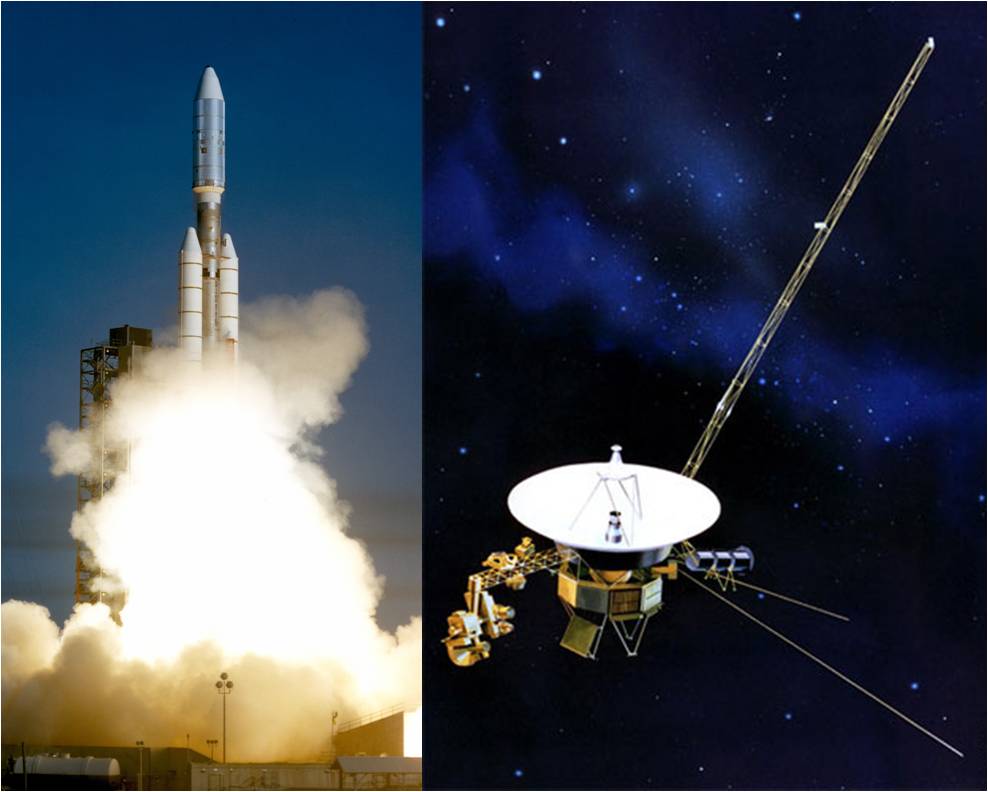
Thirty-three years ago this week, the Voyager 1 space probe was launched on a first-ever mission to fly past the planets Jupiter and Saturn. Incredibly, both Voyager 1 and its companion Voyager 2 spacecraft continue to function quite well and transmit valuable data back to Earth as they voyage eternally in deep space.
The Voyager Program was a 1970’s NASA project to investigate the giant gas planets Jupiter and Saturn. Two (2) Voyager spacecraft were launched in the summer of 1977. Each probe was extensively instrumented to measure the planetary and space environments that they would encounter. Design lifetime was 5 years.
Due to a unique alignment of Jupiter, Saturn, Uranus and Neptune that occurs every 175 years, the Voyager Program had the potential to be much more than a two-planet journey. Specifically, a gravity assist at each planet could bend Voyager’s trajectory and send it to the next outermost planet in what was termed a Grand Tour of the Solar System’s giant gas planets.
And yet there was even more potential for scientific investigation beyond the Grand Tour! Given that either or both of the Voyagers continued to operate well beyond its/their design liftetime, the opportunity to investigate interstellar space itself would be a real possibility.
Voyager 1 was launched from Cape Canaveral’s LC-41 at 12:56:00 UTC on Monday, 05 September 1977. A Titan IIIE-Centaur launch vehicle provided the energy required to send the 1,588-pound spacecraft on its deep space mission. Interestingly, Voyager 1 launch delays resulted in Voyager 2 being launched several weeks earlier (i.e., Saturday, 20 August 1977).
Each Voyager spacecraft carries a 12-inch gold-plated copper record that includes terrestrial sights and sounds as well as a variety of human speech. The intent of carrying this record is to provide the finder, ostensibly the inhabitant of another celestial world, with information about and the location of our home planet.
Voyager 1’s quicker trajectory allowed it to arrive at Jupiter (05 March 1979) prior to the arrival of Voyager 2 (09 July 1979). Voyager 1 would proceed to flyby Saturn on 12 November 1980. Voyager 2 would fly the actual Grand Tour mission by visiting Jupiter, Saturn, Uranus and Neptune. This last encounter occurring on 25 August 1989.
As historic and momentous as was the completion of Voyager’s primary and extended planetary missions, there was more in store for the twin probes. Twelve (12) years after departing Earth, both spacecraft were operating amazingly well as they headed out of the Solar System. As a result, NASA established the Voyager Interstellar Mission (VIM).
The VIM is a tri-phase investigatory effort consisting of exploration of the Sun’s termination shock and heliosheath as well as the interstellar medium itself. Voyager 1 crossed the termination shock in December of 2004 at a distance of 8.74 billion miles from Earth. Voyager 2 achieved the same milestone in August of 2007 when it was 7.81 billion miles from Earth.
Both Voyager spacecraft are currently investigating the Sun’s heliosheath. Each is still sending back scientific data. Current estimates show that Voyager 1 and 2 will continue to function through at least 2025. The hope is that at least one of the spacecraft will have entered and probed interstellar space by that time.
Meanwhile, both Voyagers soldier-on at a Sun departure rate of 335 mllion miles per year for Voyager 1 and 307 million miles per year for Voyager 2. As of this writing, Voyager 1 is more than 10.66 billion miles from Earth, making it the most distant man-made object ever sent from Earth.











